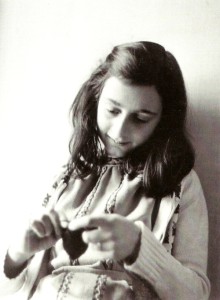A Message of Hope from Dock Street’s The Diary of Anne Frank
Your journey begins with an exquisite set design inviting you in with a bed of tulips in the forefront and a cramped shelter with the walls and floors covered in the writings of a thirteen year old dreamer. The back center wall is a soft and heartfelt black and white image of Anne Frank. Before the first words are uttered, the audience becomes part of a two year struggle for survival. Surrounded by chaos and uncertainty, these eight children and adults from different backgrounds and lifestyles endured starvation, alienation and potential death. At the heart of situation was a young, energetic young lady named Anne Frank who shared her experiences with the world through her personal and candid observations during this period of hiding.
Played with poise and emotional strength by Lila Clark, a freshman at Academic Magnet High School, Lila brought a air of innocence, warmth, hope and optimism to the stage. Her portrayal of Anne was highlighted by the many layers she exposed during her performance. Throughout the live production, you witnessed a young lady with the same dreams, boyhood crushes and imagination as any young boy or girl, but her situation was unlike any other. Throughout the performance, she brought a level of energy and complexity that complimented the acting troop and comforted the audience who watched fully aware of the impending tragedy. Her playful demeanor and mature observation of the world around her was played elegantly. As we moved toward a bitter climax, we never lost site of hope as we witnessed her first crush, her nightmare episodes and her dreams to dance and travel to Paris.
Victor Clark gave an exceptional portrayal of the role of Otto Frank, the grounded and calm father and business owner. His ability to absorb all the chaos and maintain a sense of order was a gift on stage. His relationship with Anne and ability to internalize all his fears provided salvation to the rest of the residents who hid in silence for over two years.
In the background the sounds of sirens and planes built up the tensions and inside the cramped quarters, the eight Jewish survivors waited, starving not knowing if they would live or die.
The Diary of Anne Frank as told by the Dock Street Theater, was not a story of Nazis and Jews (though a flag of Europe and Asia with a swastika was ordained on the back wall), good versus evil or coming of age. It is a story of family, hope and love. One of the greatest tragedies of this story is that a young girl, intelligent, loving and full of dreams was taken from us. In her foresight, Anne wanted to leave behind a reminder of not just her life and struggles, but all those that fought to stay alive.
Anne Frank was the biographer of a generation lost and never truly got to see the importance of her words.
As the story begins, we see a black and white image of Anne center stage on the back wall. Her father walking through the hidden shelter one final time after the war had past and the survivors were released from the concentration camps. Along with a scarf and glove on the floor, he finds Anne’s journal. For the next two hours, we are taken through those pages, feeling the pain Otto felt being the last survivor. During a Hanukkah scene in December, 1944, Otto recited the Hanukkah prayers on the first night. One candle representing his future, alone without family.
The supporting cast contributed well depicting the anger and anticipation. Complimented by Steve Fordham, who has been a fixture in the community as a long time actor, playing Jan Dussell, Benjamin McCoy as young Peter Van Daan, Maddy Seabrook as Margot Frank, Andrea Rausch and Kent Reynolds as the Van Daan’s and Beth Curley as Edith Frank, the mother of reason trying to understand why this madness was happening all around.
The strength of the performances of Lila Clark and Victor Clark to some extent minimized the contributions of the supporting cast, but overall, the actors played off of each other well and provided an excellent interpretation of Anne Frank’s writing.
The direction of the play by Julian Wiles was artistic and respectful. By creating separation points throughout the stage and panning light on the key scenes, he could capture the essence of the quarters and still provide direction to the audience on the emphasis of the scene. Whether it was Anne writing at her desk or a hug from her father after a nightmare, the soft lighting with the backdrop of darkness let us be part of something intimate.
This is an personal story told from the heart of a teenage girl. Even in the end, she never stopped believing and hoping.
In a time of adversity, we have one thing that can keep the heart strong and that is love. Anne Frank has taught millions of people that lesson in the last 70 years since her passing. Dock Street used gentleness and dignity to interpret her words and bring them back to life.




[…] A Message of Hope from Dock Street’s The Diary of Anne Frank (Charleston Daily). […]
My wife and I were in Charleston for a brief vacation – we always love going to see live theater at Dock Street, so we purchased tickets several months in advance for the Sunday matinee. I was honestly expecting to NOT love the play, just because it’s such a tough subject. But, lo and behold, my wife and I both loved it! The story was well told, and all of the cast members were wonderful. But we rather thought that the young woman playing Anne Frank was in her early twenties, despite her youthful appearance. I would never, never have believed that a high school freshman could be so poised and give such an amazing performance! Kudos to the entire cast and crew, but especially to Lila Clark – she is one to watch out for!!!